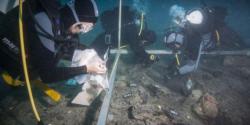INSTITUT SUPERIEUR D'ANTHROPOLOGIE
INSTITUTE OF ANTHROPOLOGY
ONLINE COURSES / COURS A DISTANCE
WINTER TERM : JANUARY 2016
REGISTER NOW
USA –  Charlottesville - The University of Virginia’s Rotunda still has its secrets, as conservators are discovering amid the building’s ongoing two-year renovation. One of them is a chemical hearth, part of an early science classroom. It had been sealed in one of the lower-floor walls of the Rotunda since the 1850s, and thus was protected from the 1895 fire that destroyed much of the building’s interior. Two small fireboxes of the hearth were uncovered in a 1970s renovation, but the hearth itself remained hidden until the current round of renovations. When preparing for the current renovations, workers examined some of the cavities in the walls and found the rest of the chemistry hearth. In Thomas Jefferson’s original Rotunda, the teaching of chemistry occurred on the Rotunda’s bottom floor – laboratory experiments and demonstrations in the Lower East Oval Room and lectures in the Lower West Oval Room. John Emmet, the first professor of natural history, who collaborated with University founder Thomas Jefferson to equip the space, taught the classes. The chemical hearth was built as a semi-circular niche in the north end of the Lower East Oval Room. Two fireboxes provided heat (one burning wood for fuel, the other burning coal), underground brick tunnels fed fresh air to fireboxes and workstations, and flues carried away the fumes and smoke. Students worked at five workstations cut into stone countertops.
Charlottesville - The University of Virginia’s Rotunda still has its secrets, as conservators are discovering amid the building’s ongoing two-year renovation. One of them is a chemical hearth, part of an early science classroom. It had been sealed in one of the lower-floor walls of the Rotunda since the 1850s, and thus was protected from the 1895 fire that destroyed much of the building’s interior. Two small fireboxes of the hearth were uncovered in a 1970s renovation, but the hearth itself remained hidden until the current round of renovations. When preparing for the current renovations, workers examined some of the cavities in the walls and found the rest of the chemistry hearth. In Thomas Jefferson’s original Rotunda, the teaching of chemistry occurred on the Rotunda’s bottom floor – laboratory experiments and demonstrations in the Lower East Oval Room and lectures in the Lower West Oval Room. John Emmet, the first professor of natural history, who collaborated with University founder Thomas Jefferson to equip the space, taught the classes. The chemical hearth was built as a semi-circular niche in the north end of the Lower East Oval Room. Two fireboxes provided heat (one burning wood for fuel, the other burning coal), underground brick tunnels fed fresh air to fireboxes and workstations, and flues carried away the fumes and smoke. Students worked at five workstations cut into stone countertops.
http://news.virginia.edu/content/jeffersonian-era-chemistry-hearth-preserved-rotunda-wall
ITALIE –  Cosenza - Italian archaeologists are to start excavations in search of a cache of ancient Roman treasure which, according to legend, was buried alongside the Gothic king who sacked the city in the 5th century. The body of Alaric, king of the Visigoths, is said to have been buried at the confluence of two rivers in Cosenza, southern Italy, alongside tons of silver and gold. The treasure is said to have included the priceless Menorah gold candelabra that the Romans looted from the Second Temple in Jerusalem in 70AD. The story of the lost treasure fascinated Hitler, who sent Heinrich Himmler, the chief of the SS, and a team of Nazi archaeologists to try to find it. They failed, as had many others before them. But now there is a fresh effort to find the loot. "Historical sources and clues confirm that the treasure of Alaric was buried in Cosenza," said Mario Occhiuto, the mayor of Cosenza. "The treasure consisted of about 10 wagons full of gold and silver, and perhaps also the sacred Jewish candelabra, the Menorah. "The town council and the provincial administration have initiated, for the first time, a plan to systematically search for the treasure, using the latest technical and scientific innovations." But others are less sure that the treasure exists. "We need to be cautious," Pietro De Leo, a medieval historian from Calabria University, told Corriere della Sera newspaper. "There are few doubts that the king of the Goths was buried in Cosenza. But I don't believe there was treasure." Alaric sacked Rome in 410AD - the first time the city had been conquered for eight centuries, and a decisive event in the decline of the western Roman Empire. He then took his armies south on a campaign to conquer other Roman redoubts. The 40-year-old chieftain is believed to have died in Calabria that same year, either in battle or from illness, possibly malaria or fever. He is said to have been buried with the treasure at the confluence of the Crati and Busento rivers. According to legend, slaves were used to temporarily divert the course of the Busento so that a magnificent tomb could be dug for the king.
Cosenza - Italian archaeologists are to start excavations in search of a cache of ancient Roman treasure which, according to legend, was buried alongside the Gothic king who sacked the city in the 5th century. The body of Alaric, king of the Visigoths, is said to have been buried at the confluence of two rivers in Cosenza, southern Italy, alongside tons of silver and gold. The treasure is said to have included the priceless Menorah gold candelabra that the Romans looted from the Second Temple in Jerusalem in 70AD. The story of the lost treasure fascinated Hitler, who sent Heinrich Himmler, the chief of the SS, and a team of Nazi archaeologists to try to find it. They failed, as had many others before them. But now there is a fresh effort to find the loot. "Historical sources and clues confirm that the treasure of Alaric was buried in Cosenza," said Mario Occhiuto, the mayor of Cosenza. "The treasure consisted of about 10 wagons full of gold and silver, and perhaps also the sacred Jewish candelabra, the Menorah. "The town council and the provincial administration have initiated, for the first time, a plan to systematically search for the treasure, using the latest technical and scientific innovations." But others are less sure that the treasure exists. "We need to be cautious," Pietro De Leo, a medieval historian from Calabria University, told Corriere della Sera newspaper. "There are few doubts that the king of the Goths was buried in Cosenza. But I don't believe there was treasure." Alaric sacked Rome in 410AD - the first time the city had been conquered for eight centuries, and a decisive event in the decline of the western Roman Empire. He then took his armies south on a campaign to conquer other Roman redoubts. The 40-year-old chieftain is believed to have died in Calabria that same year, either in battle or from illness, possibly malaria or fever. He is said to have been buried with the treasure at the confluence of the Crati and Busento rivers. According to legend, slaves were used to temporarily divert the course of the Busento so that a magnificent tomb could be dug for the king.
http://www.newindianexpress.com/world/New-Search-for-Gothic-King-and-Treasure/2015/10/17/article3084438.ece?
CROATIE –  Gnalić - Underwater research at the Gnalić site near Biograd, where the ship Gagliana sunk in the 16th century, is in full swing. Divers are working on wreckage of the ship which sank in November 1583 and removing various items: pieces of glass, parts of candlesticks, amphorae, luxury dishes and glasses, scissors, bells... The wreckage includes even some guns. So far, at the bottom of the sea more than 20,000 items have been found. Current research activities are being led by Irena Radić Rossi from the Department of Archaeology of the University of Zadar,reports Jutarnji List on October 18, 2015. "It is a rich site and my estimate is that the project will certainly take at least ten years. It all depends on how thoroughly we want to study the wreckage, and of course our goal is to explore it completely. However, the duration of the project does not really depend on our wishes, but on available funds", dr. Rossi said. Gagliana was sailing from Venice to Istanbul, carrying luxury items to the harem of Sultan Murad III. In May 1583, there was a fire in the harem at the Topkapi Palace, so the Sultan ordered its reconstruction. Among other items, in Venice he bought five thousand round windows. The cargo, and there was a lot of it since the ship could carry 720 tons of cargo, included fine fabrics intended for his mother. However, the shipment never reached Istanbul. We still do not know why the ship sank, but there are indications that it was sunk by the captain, Alvise Finardi, himself. Apparently, the ship was also carrying some diamonds, and the captain saw it as an opportunity to solve some of his personal debts. He survived the event, but many of his sailors were not so lucky.
Gnalić - Underwater research at the Gnalić site near Biograd, where the ship Gagliana sunk in the 16th century, is in full swing. Divers are working on wreckage of the ship which sank in November 1583 and removing various items: pieces of glass, parts of candlesticks, amphorae, luxury dishes and glasses, scissors, bells... The wreckage includes even some guns. So far, at the bottom of the sea more than 20,000 items have been found. Current research activities are being led by Irena Radić Rossi from the Department of Archaeology of the University of Zadar,reports Jutarnji List on October 18, 2015. "It is a rich site and my estimate is that the project will certainly take at least ten years. It all depends on how thoroughly we want to study the wreckage, and of course our goal is to explore it completely. However, the duration of the project does not really depend on our wishes, but on available funds", dr. Rossi said. Gagliana was sailing from Venice to Istanbul, carrying luxury items to the harem of Sultan Murad III. In May 1583, there was a fire in the harem at the Topkapi Palace, so the Sultan ordered its reconstruction. Among other items, in Venice he bought five thousand round windows. The cargo, and there was a lot of it since the ship could carry 720 tons of cargo, included fine fabrics intended for his mother. However, the shipment never reached Istanbul. We still do not know why the ship sank, but there are indications that it was sunk by the captain, Alvise Finardi, himself. Apparently, the ship was also carrying some diamonds, and the captain saw it as an opportunity to solve some of his personal debts. He survived the event, but many of his sailors were not so lucky.
http://www.total-croatia-news.com/lifestyle/1206-researchers-uncover-secrets-of-a-ship-sunk-almost-500-years-ago